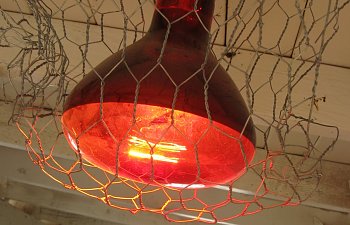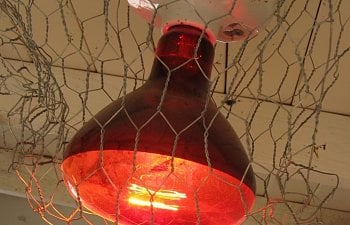It’s a question commonly asked among chicken owners; especially around this time of year. Why aren’t my chickens laying? Do they need light in the winter?
It’s common for people to give their chickens light in the winter, or even all year round. Some chicken-owners aren’t so sure. Here’s a look at both sides to help you make a decision.
Please read these before heating or running electricity to your coop! Fire Safety in the Coop and Barn and Outlet Types for Fire Safety in Your Coop
~Yes- it helps increase egg production!~
If you especially care about production, light is the way to go. There are many studies that have proven that, in almost every case, when light is added there is a significant increase in egg production. Chickens are ‘told’ to produce eggs by their endocrine system, a system of different glands and organs that produce hormones. As the daylight hours shorten in winter, changes in these hormones shut down egg production. Adding additional light triggers the endocrine system into action, causing them to produce more eggs. Continuously giving chickens light in the winter fools their bodies into thinking that the days aren’t getting shorter at all.
Why do chickens stop laying in the winter?
Most chickens produce eggs at the fastest rate when there is a better chance their offspring will survive to maturity. Chicks clearly would not survive as well in cold weather. For a chicken, that gives them no reason to lay eggs in the winter, so their bodies automatically shut off egg laying for the colder months.
Installing the light (how and when)
If you have decided to install a light, please keep in mind that lights can also be potential fire hazards. Don’t put them where the chickens can knock them down. This may create a fire that could burn down the coop and the chickens.
With that said, if you are only installing a light for the winter, it can actually be a good idea to get one that also gives off heat, depending on your climate. Chickens in warmer areas can be fine without heat lamps, although they may be helpful in colder climates or for younger birds.
You can either leave the light on 24/7 to provide constant warmth and light, or you can install a timed light. If you choose to use a timed light, you want to ensure that your chicken gets 14 hours of total light. It’s usually advised to give them the light in the early morning hours. If you do choose to let it come on at night, the main side effect may be that you have more afternoon layers.
An example of a well secured red light
Red or White Light?
In general it is advised to use red light, but there are arguments that either work. Red light is more soothing for a chicken, and helps allow them to sleep. As you could imagine, chickens probably won’t want a bright white light shining on them, especially if you are leaving it on all day/night. I’ll discuss additional advantages of red light in the next section.
Benefits of Using Red Light
There are several studies that show additional benefits of using red light. In general it is said to reduce cannibalism, be calming to the chickens, and reduce pecking problems.
This is one article I found particularly interesting on red light:
What happens when chickens see red?
“A company* that markets red contact lenses for chickens (at 20 cents a pair), points to medical studies showing that chickens wearing red-tinted contact lenses behave differently from birds that don't. They eat less, produce more and don't fight as much. This decreases aggressive tendencies and birds are less likely to peck at each other causing injury. A spokesman said the lenses will improve world egg-laying productivity by $600 million a year.
(Perhaps everything looks red and they cannot distinguish combs, wattles, or blood. Or ...perhaps the chickens are happier because they're viewing the world through rose colored glasses.)” http://www.colormatters.com/color-and-vision/color-and-vision-matters
While this study may seem a little far-fetched, red can make an impact in egg laying. Several other credible chicken books also mention the benefits of red light.
Note: If you do choose to use a red light, or even if you choose white, it is advised not to switch back and forth. This can further stress out the chickens and lead to drops in egg production.
Now that we’ve covered the advantages of using lighting, let’s look at the negative arguments of the issue.
~No- let nature take its course!~
Why should we add artificial light?
Most chicken owners aren’t running commercial operations. If all you really want is production, production, production, then it may make sense to add additional lighting, but if your chickens are pets, why not just let nature take its course?
Chickens deserve (and need) a rest
Let’s face it: chickens aren’t egg machines. Egg laying is stressful on a chicken, and it takes a lot of work for chickens to pump out eggs daily. Even humans get time off from their jobs; why not chickens? Winter is a chicken’s time to naturally shut down and rest from laying eggs all summer long. Don’t they deserve a break?
Providing additional light is taxing in the long run
If you force a bird to lay during the cold months by triggering her endocrine system with extra light, you can also shorten her laying longevity. To quote poultrykeeper.com:
“Since a hen is born with all of the eggs she can produce in her life already inside her, if you intend to keep your hens for their entire life then you aren't gaining anything in the long run by providing extra light for them, but you will be able to get a supply of eggs during the winter months.”
The article goes on to talk about the potential health hazards of forcing your chickens to lay during the winter, especially if you are forcing them to lay when they really need to rest, for example when they are molting.
While many people advise using lights, there is also a general acknowledgment that this can actually be harmful for their health, and stop them laying sooner. You can use artificial light and get a burst of eggs for a short amount of time, or let nature take its course, and allow the chicken to lay naturally throughout her life. For example, I have a seven year old red star that has never had artificial light, and she still lays. As a whole, lighting can actually have a negative impact in the long run for your flock. Unless you only care about production, you may have healthier chickens by letting them lay naturally.
As long as you have healthy, happy chickens, you should still get some eggs in the winter. Make sure to also ensure that your chickens are mite and worm free, as these can lead to drops in egg laying as well. If you care especially about getting eggs in the winter, but don’t want to use lighting, you can also look into getting some more winter hardy breeds that are known to lay better, such as the Salmon Faverolle and Easter Egger.
~
In conclusion, it’s really your decision. Are you raising birds mainly for production, or keeping them as a flock of fluffy pets? Hopefully you’ll be able to make the perfect decision for your individual flock. I hope this article has helped you with that decision. NOTE: (credit/thanks to gickelvolk)
Should you decide to use a light BE CAREFUL OF THE LIGHT YOU CHOOSE!!!
"Industrial Duty" and "Break-Free" bulbs have a TOXIC coating (generally a Teflon) on them to prevent shattering upon breakage. The bulb emits a gas from the coating and it is DEADLY to poultry.


